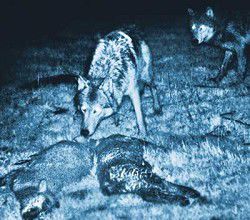Ranchers react to wolf attack
Published 5:00 pm Wednesday, April 22, 2009

- An ODFW camera captured images of wolves returning to a kill in Baker County.
Twice within the last eight days, two wolves ventured within 200 yards of a ranch house near the Baker County town of Keating, killing 19 lambs and sending a rush of concern through Eastern Oregon ranchers.
“It’s pretty devastating to the livestock community to start watching this happen,” Oregon Farm Bureau Director of Government Affairs Katie Fast said. “This was not in the back woods somewhere. It’s near homes.”
The attacks on April 9 and April 12 about 15 miles northeast of Baker City at the ranch of Curt and Annie Jacobs are the first confirmed cases of an Oregon rancher losing livestock to wolves since the 1930s, when wolves were hunted to extinction in Oregon.
The first attack, on Thursday, April 9, set in motion an investigation by state and federal wildlife officials, who placed cameras at the sites where the lambs were attacked. The two wolves were photographed Sunday night killing two lambs.
Seventeen lambs died in the Thursday night attacks.
Since that time, other injured lambs have died brining the total to 24 dead.
Wildlife officials this week placed padded leg traps at the ranch in hopes of capturing the wolves and fitting them with radio collars.
The collars will allow officials to find and kill the wolves if depredation persists and if nonlethal prevention methods (such as hazing them away from livestock) fail, ODFW Northeast Region Manager Craig Ely said.
The collars also trigger a radio-activated guard that flashes lights and generates noise when the wolves wander within a certain distance of a radio transmitter. The “RAG boxes,” as they are known, are being used along with other nonlethal measures to prevent further depredation at the ranch, Ely said.
Under state and federal law, government wildlife agents can kill problem wolves only after depredation has occurred and nonlethal prevention methods are exhausted. The wolves will most likely not be relocated. USFWS Wolf Recovery Coordinator Ed Bangs said that relocation had not been practiced in the Northern Rocky Mountain Area since 2001. “Last year we (USFWS) killed 264 wolves in the Northern Rocky Mountain Area,” he said. “That’s 14 percent of the wolf population. We’ve moved wolves 117 times between 1989 and 2001 but we haven’t moved them since then. We’ve got so many there’s no place to move them to. We’ve got 645 wolves roaming around.”
ODFW said in a press release Wednesday, April 15, the department is working the case under the guidance of the U.S. Fish and Wildlife Service, which is responsible for managing wolves in Oregon until wolves are delisted from the federal Endangered Species Act.
U.S. Interior Secretary Ken Salazar announced earlier this year U.S. Fish and Wildlife Service was proposing to delist the wolves effective May 4. However, according to Bangs, “Five notices of attempt to sue have already been filed (to halt de-listing).”
Wolves also are protected in Oregon under the state Endangered Species Act.
State take restrictions under current law will remain in place regardless of the federal status until the wolf population in Oregon reaches four breeding pairs for three consecutive years.
Ranchers hope to change state law to allow take flexibility in cases of wolf depredation.
“We’re looking for the ability to protect our property in the event of wolf problems,” said Oregon Cattlemen’s Association President Bill Moore, who ranches in nearly Unity, Ore.
“We don’t want to do a wholesale slaughter of wolves,” he said, “but if there are problem wolves, we want to protect our private property.”
At least one legislative proposal before lawmakers would align state wolf take provisions with federal take provisions.
When asked if the Keating-area attack would help move forward the legislation, Fast said, “I would hope so.
“When we have people whose livestock and possibly their lives are being compromised because of our wildlife policy, I would hope that would spur the Legislature,” Fast said.
Defenders of Wildlife said it will compensate the ranchers for the lambs at fall-market value – typically about $120 per lamb.
State officials currently believe at least three pairs of wolves roam Eastern Oregon. They believe at least two of the pairs are breeding pairs.
The ODFW wolf report for December 2008 records 30 sightings, 26 in Eastern Oregon. Sightings by hunters accounted for nearly half that number. Of the 21 actual sightings of wolves, 13 were of paired or multiple wolves. Seven of the sightings statewide were of tracks only, one was a report of howling, one a report of wolf scat found. ODFW followed those reports up with 16 days of investigation, including tracking collared wolves by air. In March of 2009, ODFW recorded 14 wolf reports, some of sightings that took place in year’s past. On follow up, wolf tracks were found in Keating.





